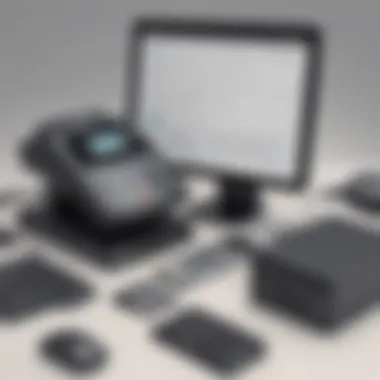Choosing the Best POS Systems for Auto Repair Shops


Intro
The realm of auto repair shops is becoming increasingly competitive. As such, business owners must leverage tools that optimize efficiency and enhance customer experience. One integral component of such tools is the Point of Sale (POS) system. These systems are not merely cash registers; they are sophisticated software solutions that manage sales transactions, track inventory, and streamline communication with customers. This guide offers insightful evaluation criteria for selecting the most suitable POS systems for auto repair shops, dissecting essential features and weighing market options.
Software Overview
Definition and Purpose of the Software
A POS system serves as the technological backbone for managing sales and customer interactions. For auto repair shops, this software can simplify tasks ranging from payment processing to inventory management. It ensures that transactions are recorded accurately and efficiently, allowing business owners to focus on their core activities—repairing vehicles and servicing customers.
Key Features and Functionalities
When evaluating POS systems specific to auto repair shops, several features stand out:
- Sales Management: This feature allows the tracking of daily sales, enabling quick insights into revenue streams.
- Inventory Control: A robust inventory management function helps maintain stock levels of parts and supplies.
- Customer Relationship Management (CRM): This functionality aids in building long-term customer relationships by storing contact information, preferences, and service histories.
- Reporting and Analytics: Detailed reports enable business owners to understand performance metrics, such as sales trends and employee productivity.
- Integration Capabilities: A good POS system can integrate with other software, including accounting and marketing platforms.
Integrating these features can notably enhance the operational efficiency of an auto repair shop.
Comparison with Alternatives
Overview of Competitors in the Market
The market for POS systems is vast, with numerous providers offering solutions tailored to various industries. Popular systems in the auto repair sector include RepairShopr, Shop-Ware, and Baymard Institute. Each of these platforms provides unique functionalities designed to streamline processes in repair shops.
Key Differentiators
While many POS systems share common features, they differ in several aspects:
- User Experience: Ease of use can greatly affect staff productivity. A system with a user-friendly interface reduces training time.
- Cost Structure: Some systems may involve a one-time purchase fee, while others employ subscription-based pricing.
- Customer Support and Training: The level of support offered can be a deciding factor, especially for smaller businesses that may not have extensive IT resources.
Assessing these factors is vital. Each business's needs are distinct; hence, the right solution relies on specific operational requirements and customer service goals.
Understanding POS Systems
Understanding Point of Sale (POS) systems is critical in the context of auto repair shops. These systems serve as much more than just cash registers; they are integrated solutions enhancing efficiency and customer service. The influence of POS on daily operations is profound, as they manage transactions, track inventory, and support customer relationship management. For a business owner, knowing the ins and outs of POS systems can lead to better decision-making and improved profitability.
Definition and Functionality
A POS system is a combination of hardware and software that allows businesses to conduct sales transactions. The hardware can include devices like barcode scanners, receipt printers, and tablets, while the software manages inventory, sales reporting, and customer data. When a customer makes a purchase, the POS system records the transaction, updates inventory levels, and generates a receipt. It also handles various payment methods, from cash to card transactions. In essence, it functions as the central hub for sales activity, streamlining the entire process from transaction to inventory management.
Importance in Auto Repair Shops
For auto repair shops specifically, the POS system is invaluable. It facilitates smooth transactions and enhances customer experience. As vehicles come in for service, technicians need quick access to parts and services. A reliable POS system ensures that accurate inventory data is available at all times.
Moreover, customer service is often a make-or-break factor in auto repairs. Quick access to customer history allows staff to offer personalized services, boosting customer satisfaction. Additionally, POS systems can help in managing appointments and tracking service history, which is crucial for follow-ups.
The implementation of POS systems in auto repair shops can significantly impact efficiency and customer relations. They make everyday operations smoother, ensuring that nothing falls through the cracks and that customers leave satisfied.
"Investing in a robust POS system is an essential step for auto repair shops aiming for operational excellence and improved profitability."
In summary, understanding POS systems not only enables better tactical decisions but also contributes to the long-term growth and sustainability of auto repair businesses. With the right knowledge, shop owners can strategically implement systems that align with their specific operational needs.
Key Features of POS Systems for Auto Repair
Understanding the key features of POS systems for auto repair is crucial for shop owners. These features can streamline operations, improve accuracy, and enhance customer service. Selecting a system with the right functionalities can greatly impact daily operations and overall business success.
Inventory Management


Effective inventory management is often considered the backbone of any auto repair shop. A POS system with robust inventory management tools helps shop owners keep track of parts and supplies efficiently. When a shop can easily monitor stock levels, it reduces the risk of running out of vital components. This functionality often includes real-time updates and alerts for low stock situations, allowing for timely reordering.
Additionally, good inventory management can provide insights into which products are moving fast and which are not. This data is essential for making informed decisions about stock purchases. Understanding demand patterns can lead to better profit margins by eliminating excess inventory and ensuring popular items are always on hand.
Customer Relationship Management (CRM)
A strong Customer Relationship Management (CRM) function within a POS system is indispensable for sustaining customer loyalty. An integrated CRM can track customer history, service preferences, and feedback. This information allows shops to tailor their services to individual needs, creating a personalized experience for each customer.
Moreover, CRMs can help in keeping in contact with clients through automated reminders for service appointments or follow-ups after repairs. By maintaining communication, shops can enhance engagement and improve customer retention rates. This level of care can distinguish a shop from its competitors, making it vital for long-term success.
Integration with Accounting Software
Integration capabilities with accounting software can't be overlooked in a POS system. An effective POS system should allow seamless data transfer between sales and financial records. This reduces the likelihood of errors that can occur with manual entry and helps ensure financial statements reflect the true state of the business.
Popular accounting platforms like QuickBooks or Xero can often be integrated with POS systems, streamlining end-of-month financial reports and simplifying tax preparation tasks. Business owners can focus on strategic decisions instead of getting bogged down in accounting errors.
Reporting and Analytics
Reporting and analytics features are essential for understanding the performance of an auto repair shop. A capable POS system should offer detailed reports on sales data, customer behavior, and inventory turnover. These analytics help shed light on trends within the business, allowing for strategic adjustments to pricing, marketing, and staff allocation.
Furthermore, access to real-time data can aid in making quick decisions based on current performance rather than relying on outdated information. Managers can identify peak times for service and adjust staffing levels accordingly. By leveraging reporting tools, shop owners can enhance operational efficiency and support sustained growth.
"Investing in a POS system with comprehensive features can significantly enhance your operational prowess, ultimately leading to increased profitability."
In summary, the key features of POS systems for auto repair shops play a pivotal role. From inventory management and CRM to accounting integration and robust reporting capabilities, each aspect contributes to a more streamlined and efficient business operation. The right POS system can not only improve day-to-day tasks but also pave the way for future growth.
Benefits of Implementing a POS System
Implementing a POS system can significantly transform operations within auto repair shops. This is not just about updating technology; it is about enhancing how the entire shop functions. By integrating a modern POS, businesses can streamline processes, improve customer interactions, and ensure financial accuracy. Here, we explore three key benefits: operational efficiency, enhanced customer experience, and accurate financial tracking.
Operational Efficiency
One of the foremost benefits of a POS system is operational efficiency. Traditional methods can often be slow and prone to errors. With a POS, tasks like inventory management and appointment scheduling become more automated.
- Improved workflow: Technicians can access customer history and vehicle information quickly. This saves time for both staff and customers.
- Speedier transactions: Payments can be processed faster, reducing wait times for customers and increasing throughput for the shop.
- Real-time updates: Inventory levels are updated immediately after a transaction occurs. This provides immediate visibility into stock levels, helping to prevent over or under-stocking of essential parts.
These enhancements lead to a smoother operation, allowing staff to focus more on service quality rather than administrative tasks.
Enhanced Customer Experience
A POS system also enhances customer experience in critical ways. Satisfied customers are likely to return and recommend the shop to others, which is vital for business growth.
- Personalized service: By accessing past service records, technicians can tailor maintenance and repair suggestions better. This shows customers that their loyalty is recognized and valued.
- Convenient payment options: Many POS systems support diverse payment methods, from cards to mobile wallets. This level of flexibility can make a big difference for customers who appreciate ease.
- Loyalty programs: Some POS systems have the capacity to integrate customer loyalty programs, allowing for rewards and discounts that keep customers engaged and coming back.
When customer's needs are met more effectively, their loyalty to the shop increases, leading to higher sales.
Accurate Financial Tracking
Accurate financial tracking is another significant advantage. A POS system provides a comprehensive view of sales data and inventory, which is crucial for financial management.
- Detailed reports: Most systems can generate detailed reports on sales performance and profit margins. This can help in making informed decisions about pricing and promotions.
- Cost control: Accurate tracking of inventory usage can help identify trends leading to cost control, minimizing waste and maximizing profitability.
- Tax compliance: Automated records make it easier to prepare for tax submissions. This reduces the likelihood of errors during tax season, ensuring compliance.
With precise financial tracking, business owners can monitor performance closely and strategize accordingly.
Implementing a POS system can be the linchpin for operational success in auto repair shops, impacting customer satisfaction and financial integrity positively.
Evaluating POS Options
When considering a Point of Sale (POS) system for an auto repair shop, the evaluation phase is crucial. This is where shop owners must sift through various options to find a solution that aligns with their specific needs. The goal is to enhance operational efficiency while ensuring customer satisfaction. The evaluation process should cover multiple aspects that can affect the day-to-day operations of the business.


Criteria for Selection
Effective selection of a POS system involves a clear understanding of what features are essential for an auto repair shop. Some of the key criteria that should guide this choice include:
- Usability: A user-friendly interface can greatly reduce training time and improve staff productivity.
- Integration: The system's ability to integrate with existing tools is vital. For instance, integrating with accounting software or inventory management systems can streamline operations.
- Supported Payment Methods: It is essential for a POS system to support various payment methods, including credit cards, digital wallets, and mobile payments. This flexibility enhances customer experience.
- Reporting Features: Look for systems that offer comprehensive reporting. These insights help in making data-driven decisions that can benefit the business.
Assessing each of these criteria will help narrow down the options and identify solutions that truly serve the needs of the shop.
Vendor Reputation
The reputation of the vendor is another significant factor to consider. A well-established vendor may offer a level of reliability and support that a lesser-known one cannot. Evaluating vendor reputation involves:
- Reviews and Testimonials: Research customer reviews on platforms like Reddit or Facebook. Real-world feedback can provide insights into the user experience.
- Industry Experience: Vendors with a background in the auto repair sector may have tailored features that cater specifically to this industry.
- Support Services: Consider the type and level of support a vendor provides. Prompt support can minimize downtime in case of system issues.
A vendor's reputation often reflects the quality of their product and customer service.
Cost Considerations
Cost is always an important aspect when evaluating options. It is vital to consider not just the initial purchase price but also ongoing costs. These may include:
- Monthly Subscription Fees: Many modern POS systems operate on a subscription model. Understanding these fees is crucial for budgeting.
- Transaction Fees: Some systems charge fees for each transaction processed. This can add up over time.
- Maintenance and Upgrades: Consider if there are costs associated with software updates or hardware maintenance.
It is advisable to collect quotes from multiple vendors to ensure a reasonable and competitive pricing structure that fits the shop's financial goals.
"The right POS system can either enhance or hinder your business processes. It’s more than just software; it’s an integral part of your operations."
In summary, evaluating POS options for an auto repair shop requires a careful consideration of criteria for selection, vendor reputation, and cost considerations. Each of these factors plays a significant role in determining the overall suitability and effectiveness of a POS system.
Integrating POS with Existing Systems
Integrating a Point of Sale (POS) system with existing infrastructure is crucial for auto repair shops. This integration influences the effectiveness of the software, enhances operational workflows, and ultimately improves customer satisfaction. A seamless transition ensures that the data across various systems works harmoniously, allowing for better decision-making and reporting. Understanding how to merge new technologies with what is already in place can lead to improved efficiency and less disruption in day-to-day operations.
Assessing Current Infrastructure
Before implementing a new POS system, it is necessary to evaluate the current infrastructure. Different components already in use should be reviewed, including the existing customer management system, inventory management tools, and any financial software. This assessment involves understanding how data is currently captured and utilized. Knowing the limitations of existing systems allows shops to choose a POS that fills any gaps. Without this knowledge, organizations risk adopting a system that does not complement or enhance current operations, which can lead to inefficiencies.
- Evaluate Hardware: Consider the compatibility of existing hardware such as computers, tablets, and card readers with the new POS software.
- Understand Software Interdependencies: Identify how current applications interact. Ensuring the new POS can integrate with these systems will prevent data silos.
- Connectivity Requirements: A reliable internet connection is essential for cloud-based solutions. Evaluate the current connectivity and make necessary improvements to support new solutions.
Data Migration Challenges
Transitioning from an old POS to a new one often involves significant data migration efforts. These challenges can vary in complexity but generally include transferring customer information, inventory details, and sales history. Ensuring data cleanliness and format compatibility is vital. Failure to properly migrate data can lead to fragmented records and poor customer service.
- Data Quality: Analyze existing data for accuracy. Cleaning data before migration reduces complications during the transition.
- Format Compatibility: Different systems may use varying data formats. Knowing how to convert data into an acceptable format for the new POS is a critical step.
- Backup: Always maintain backups of existing data before starting the migration process. This ensures that information is not lost or corrupted during the transfer.
Training Staff for Smooth Transition
Training staff effectively is perhaps one of the most overlooked aspects of integrating a new POS system. Employees must be comfortable and proficient with the new technology to leverage its full potential. Not only does training enhance productivity, but it also minimizes user errors that could lead to frustration and inefficiencies.
- Comprehensive Training Sessions: Organize training sessions that cover all aspects of the new system, from basic operations to advanced features.
- Ongoing Support: Provide resources and support to answer questions that arise post-implementation. This can involve creating accessible documentation or setting up a hotline.
- Feedback Mechanisms: Encourage staff to share their experiences using the new system. This feedback can be valuable for refining processes and enhancing training programs in the future.
Integrating a new POS system requires thorough planning and execution. By assessing the current infrastructure, addressing data migration challenges, and properly training staff, auto repair shops can ensure a successful implementation that enhances their operations.
Analyzing Case Studies
Auto repair shops face unique challenges and complexities that can impact their operations. Through case studies, shop owners can observe how different systems streamline processes, improve customer satisfaction, and enhance overall efficiency. These narratives often distill technical jargon into relatable scenarios, making it easier for decision-makers to comprehend the practical implications of their choices.
Furthermore, case studies allow businesses to learn from the experiences of others. This aspect is crucial, as it can guide shop owners in avoiding potential pitfalls. Instead of relying solely on vendors' promises, decision-makers can make more informed evaluations grounded in actual performance indicators.
"Learning from the successes and failures of peers can provide invaluable insights that affect POS system selection decisions."


Success Stories
Examining success stories of auto repair shops using specific POS systems highlights the tangible benefits these solutions offer. Many shops report significant improvements in their efficiency and customer service. For instance, a popular auto repair shop in Denver adopted the Shop-Ware POS system. This change led to a 30% reduction in service time and improved parts tracking.
These stories often feature key metrics that illustrate the impact of the new systems. Common factors include:
- Increased ticket sizes due to streamlined upselling processes.
- Higher customer retention rates from improved service features.
- Enhanced inventory management that reduces stock-outs and overstock issues.
In addition to quantitative benefits, many shops report a qualitative improvement in staff morale. When employees have effective tools, it reduces stress and helps them focus on customer interaction.
Lessons Learned
Analyzing lessons learned from case studies provides essential takeaways for other auto repair shops considering similar investments. A few recurring challenges surface across multiple stories, equipping shop owners with foresight.
- Integration Issues: Many shops faced challenges with integrating their new POS systems with existing software. A thorough assessment before implementation can mitigate this risk.
- Training Needs: The lack of comprehensive training can lead to underutilization of the system's features. Shops that invested time in training employees reported smoother transitions.
- Vendor Support: Reliable customer support is a necessity. Shops with swift access to vendor assistance adapt more quickly to system changes and updates.
In summary, case studies offer a lens through which decision-makers can evaluate the effectiveness of various POS solutions. The success stories portray a brighter outlook, while the lessons learned contribute to more informed choices in the future.
Future Trends in POS Systems for Auto Repair
As technology evolves, so too do the tools that support businesses in the automotive sector. Understanding the future trends in POS systems for auto repair is essential for shop owners wanting to maintain a competitive edge. Embracing innovative technologies not only improves operational efficiencies but also significantly enhances customer service experience. This section explores two key areas: mobile and cloud-based solutions, and the role of artificial intelligence and automation in transforming POS systems.
Mobile and Cloud-Based Solutions
Mobile solutions have become increasingly integral to the way automotive repair shops operate. With mobile point of sale systems, technicians can process transactions directly on the shop floor, reducing wait times for customers. These systems are also flexible, allowing businesses to conduct sales from almost anywhere, improving customer interactions.
Cloud-based POS systems offer several benefits. First, they provide real-time access to information from anywhere with an internet connection. This capability enables shop owners to monitor sales, inventory, and customer interactions in real-time. Second, cloud storage reduces the risk of data loss, as information is backed up automatically on secure servers.
Some features of mobile and cloud-based solutions include:
- Scalability: Easy to add new features or upgrade as the business grows.
- Cost-Efficiency: Often involve lower upfront costs and reduce the need for extensive hardware.
- Improved Collaboration: Staff can access shared records, facilitating better teamwork.
Adopting these solutions positions auto repair shops to respond swiftly to customer demands and optimize resource management.
Artificial Intelligence and Automation
The introduction of artificial intelligence (AI) and automation into POS systems marks a significant shift in how auto repair shops conduct business. AI can analyze customer data to offer personalized recommendations, potentially increasing sales and fostering customer loyalty.
Automation simplifies day-to-day operations by handling routine tasks, such as inventory management or appointment scheduling. This leaves staff free to focus on more complex tasks and customer relationships. For instance, automated reminders can help remind customers about upcoming service intervals, improving customer engagement and retention.
Key advantages of AI and automation include:
- Enhanced Decision Making: Data-driven insights enable better strategizing.
- Efficiency: Reduces time spent on repetitive tasks through automation.
- Cost Savings: Minimizes errors, lowering operating costs due to more accurate data handling.
Overall, AI and automation are pivotal in steering auto repair shops toward greater efficiency and improved customer satisfaction.
Investing in future trends not only aids in immediate efficiency but prepares businesses for coming changes in customer expectations and technology.
End
In this article, we explored various aspects of Point of Sale (POS) systems tailored for auto repair shops. The conclusion highlights the essential findings from throughout our discussion, encouraging business owners to reflect on the necessity of upgrading or implementing a POS system.
Recap of Key Insights
To summarize, several key insights emerged:
- Functionality: A POS system is not just a simple cash register. It serves as a comprehensive tool that manages various operations, from sales tracking to inventory management.
- Benefits Realized: Implementing a well-chosen POS system can lead to enhanced operational efficiency, improved customer service, and more accurate financial tracking.
- Evaluation Criteria: One must consider vendor reputation, costs, and system compatibility when selecting a POS solution. Careful assessment can prevent future complications and ensure a smooth transition.
- Future Trends: Staying updated with trends like mobile solutions and AI integration can provide a competitive edge.
These insights reinforce the significance of POS systems in driving profitability and service quality in auto repair environments.
Final Thoughts on Selection
Choosing the right POS system involves more than just evaluating features. It's about alignment with business goals and customer expectations. Being mindful of how the selected system integrates with existing workflows is also crucial. As businesses grow and adapt, their need for flexible and scalable systems increases. Evaluating POS systems is an ongoing process. Regularly assessing the performance and capabilities of the current system ensures it continues to meet the evolving needs of the business.
Ultimately, the decision to enhance or switch POS systems should be approached with diligence. By considering the unique challenges and opportunities presented within the auto repair industry, owners can position their shops for long-term success. In closing, the right POS system is not merely a tool, but a transformative component that can significantly elevate operational standards and customer satisfaction.















